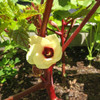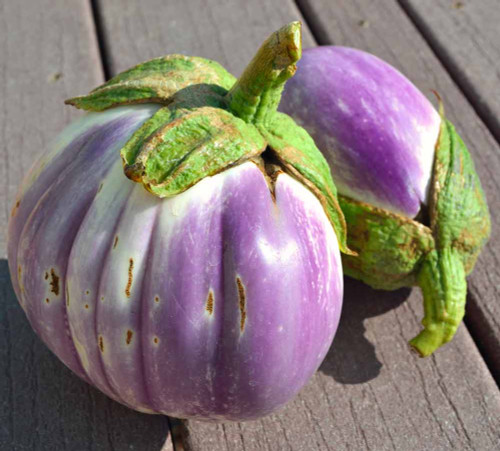Description
Red Burgundy Okra - The Ruby Jewel of Your Summer Garden
Step into a vibrant world of color and flavor with Red Burgundy Okra, also known as Burgundy Okra, Red Okra, or Red Clemson Okra, a Southern heirloom that will brighten your garden and kitchen. This isn't your average okra; its deep crimson pods are a feast for the eyes, retaining their jewel-like shade even after cooking. Bred for excellence at Clemson University, this All-America Selections winner’s gifts go far beyond the dinner table.
This ornamental edible adds a burst of color to your garden with its striking red pods and lush foliage. The abundant bright yellow flowers are considered by many to be some of the most beautiful in the vegetable garden. Michael W. Twitty, author of the James Beard award-winning book The Cooking Gene, described the flowers as “..the most gorgeous of mallows, with a flower that reminds you of the umbrella of a crinoline-laden bell on a summer afternoon.”
Red Burgundy thrives in warm climates, making it a perfect choice for sunny gardens. Its versatility in the kitchen is extensive – whether you prefer it in stir-fries, soups, stews, or pickles, its unique flavor and texture will enhance your dishes.
By growing Red Burgundy Okra, you're not just cultivating a delicious vegetable; you're embracing a piece of Southern culinary history and adding a touch of elegance to your homegrown harvest.
Details
Red Burgundy Okra is an eye-catching visual treat in your garden. Its deep red pods, defined with subtle ridges, hang like jewels amongst deep green foliage. The plant is manageable at 3-4 feet tall, making it ideal for smaller gardens or even container gardening. But the magic happens when its vibrant yellow flowers with striking red centers open.
As the pods develop, reaching an average of 6-8 inches, they maintain their stunning crimson shade during cooking, adding a splash of color to your dishes. Red Burgundy's texture is delightfully crisp and tender, unlike some okra varieties. Its mild, slightly sweet flavor with a hint of nuttiness is especially mild when harvested young, up to 4-6 inches long, making it a favorite for even the most discerning palates.
History
You can still find Okra’s ancient ancestors growing wild in Ethiopia, where it is believed to have originated, to the White Nile in Egypt. Ethnobotonists believe it arrived in India after about 200 AD, where it was traded into Arabia. One of the earliest mentions of okra was noted by a Spanish Moor who traveled with the Muslim warrior prince Saladin during the Crusades when he saw it growing in Egypt in 1216 AD.
Okra reached the Americas sometime before 1658, probably reaching Brazil and Dutch Guyuna first with slaves from the Gold Coast of Africa and then traveling northward into North America. By 1748, it was grown in Philadelphia, and Thomas Jefferson noted it in his gardens at Monticello in 1781. From about 1800 onwards, okra found a new home in the American South, becoming a staple ingredient in dishes like gumbo and stews, cherished for its versatility and unique ability to thicken sauces.
Fast forward to the 1980s, when a horticulturist at Clemson University, Leon Robbins, embarked on a rigorous breeding program, meticulously selecting for exceptional flavor, vibrant color, and high yield. After years of meticulous breeding and careful selection, Red Burgundy Okra was released to the public in 1983. Its vibrant red pods, exceptional flavor, and high yield quickly captured the hearts of gardeners and chefs alike. In 1988, Red Burgundy Okra received the esteemed All-America Selections award, solidifying its place as a beloved heirloom variety in gardens nationwide.
Uses
Red Burgundy Okra is a versatile ingredient that can elevate your culinary creations and enhance your garden's beauty. It's truly adaptable in the kitchen. Its vibrant red adds a pop of color to a stir-fry, simmers into a hearty soup or stew, or is added to a rich gumbo. Its tender texture and mild flavor make it a perfect addition to curries or even crispy fritters. Pickled Red Burgundy Okra is a delight for those seeking a tangy twist. Its unique color and taste preserve it for year-round enjoyment.
Are you worried about the texture? Never fear; with a couple of simple techniques, you can easily have a delightfully crisp and tender okra. Harvest the pods when they are young (2-4 inches long), cook them quickly over high heat, and incorporate acidic ingredients like lemon juice, tomatoes, or vinegar. You can further reduce the potential for slime by avoiding cutting the pods, as they contain acetylated acidic polysaccharides and galacturonic acids, which are slippery compounds that are released when the pod is cut.
Beyond the kitchen, Red Burgundy Okra shines as a garden gem. Its striking red pods and bright yellow flowers create a fascinating display, adding bursts of color and architectural interest to borders, raised beds, or containers. These beautiful blooms also attract various beneficial pollinators like bees and butterflies, enhancing your garden's overall health.
Companion Planting
Beneficial companions include beans, cucumbers, eggplant, melons, peppers, and tomatoes. Okra provides shade and attracts beneficial insects that deter pests. Marigolds and nasturtiums add beauty and help to repel pests.
Antagonistic plantings include potatoes and sweet potatoes. These heavy feeders can compete for nutrients and space.
Pest and Disease Management
Okra is a relatively resilient plant but is not entirely immune to pests and diseases. Common pests like aphids, stink bugs, and corn earworms may occasionally visit your okra plants. Frequent inspection and handpicking of the pests is an option for smaller infestations. Introducing beneficial insects like ladybugs and lacewings into your garden can help keep pest populations in check.
Powdery mildew can leave a white powdery coating on the leaves. To prevent these issues, ensure your plants are grown in well-draining soil and practice crop rotation.
Planting and Growing Tips
Don't fuss too much over your okra plants – they're known for their resilience and adaptability. It's a vigorous grower, even in hot climates, and requires minimal maintenance once established. If you're new to gardening, you’ll succeed with this okra.
Hold off on planting until the danger of frost has passed and the soil temperature consistently reaches 65°F or higher. Depending on your region, this typically falls in late spring or early summer. Your patience will be rewarded with vigorous growth and a bountiful harvest.
Okra grows best in full sun in well-draining, fertile soil enriched with compost or other organic matter, which provides the necessary nutrients for healthy plants.
Soaking the seeds up to 12 hours before planting speeds up germination. Plant your Red Burgundy Okra seeds 12-18 inches apart in rows 3-4 feet apart. This gives each plant room to spread and produce well. Remember, okra is a thirsty plant, especially during hot weather, so keep the soil consistently moist but not waterlogged. A drip system on a regular watering schedule and a layer of mulch help maintain the ideal moisture level and suppress weeds.
Harvest Tips
Red Burgundy Okra is a generous producer, giving you an extended harvest of red pods. The key to its peak flavor and tenderness is in the timing of your harvest. Start checking your plants about 50-60 days after planting, and be ready to harvest frequently, ideally every other day, to encourage continued production. The ideal time to pick is in the morning when the pods are at their freshest and most tender.
Look for pods that are 2-4 inches long. They'll be crisp and flavorful at this stage, with minimal mucilaginous quality. To harvest, simply use a sharp knife or pruner to cut the pod's stem, leaving a small piece attached. Don’t pull the pod from the stem, as that leaves a tear that can damage the plant and invite disease and pest insects.
Make sure to harvest regularly! The more you pick, the more the plant will produce throughout the summer.
Learn More
From the soil to the seed to the food you eat - we'll help you grow your best garden!
2 Reviews
-
Red Burgundy Okra
These long red pods stay tender past 6" long. The plants are beautiful in the landscape and is a vigorous producer. Does well even in deep summer heat in central FL.
-
Good Seeds
Good germination rate on these seeds. I wouldn't say Red Burgundy is the best producing okra ever, but it produces well enough and it's an interesting looking okra with neat pods.























